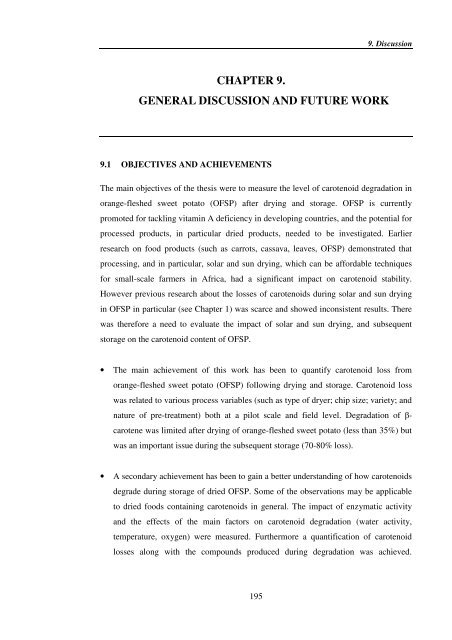Investigating carotenoid loss after drying and storage of
Investigating carotenoid loss after drying and storage of
Investigating carotenoid loss after drying and storage of
Create successful ePaper yourself
Turn your PDF publications into a flip-book with our unique Google optimized e-Paper software.
CHAPTER 9.<br />
GENERAL DISCUSSION AND FUTURE WORK<br />
9.1 OBJECTIVES AND ACHIEVEMENTS<br />
195<br />
9. Discussion<br />
The main objectives <strong>of</strong> the thesis were to measure the level <strong>of</strong> <strong>carotenoid</strong> degradation in<br />
orange-fleshed sweet potato (OFSP) <strong>after</strong> <strong>drying</strong> <strong>and</strong> <strong>storage</strong>. OFSP is currently<br />
promoted for tackling vitamin A deficiency in developing countries, <strong>and</strong> the potential for<br />
processed products, in particular dried products, needed to be investigated. Earlier<br />
research on food products (such as carrots, cassava, leaves, OFSP) demonstrated that<br />
processing, <strong>and</strong> in particular, solar <strong>and</strong> sun <strong>drying</strong>, which can be affordable techniques<br />
for small-scale farmers in Africa, had a significant impact on <strong>carotenoid</strong> stability.<br />
However previous research about the <strong>loss</strong>es <strong>of</strong> <strong>carotenoid</strong>s during solar <strong>and</strong> sun <strong>drying</strong><br />
in OFSP in particular (see Chapter 1) was scarce <strong>and</strong> showed inconsistent results. There<br />
was therefore a need to evaluate the impact <strong>of</strong> solar <strong>and</strong> sun <strong>drying</strong>, <strong>and</strong> subsequent<br />
<strong>storage</strong> on the <strong>carotenoid</strong> content <strong>of</strong> OFSP.<br />
• The main achievement <strong>of</strong> this work has been to quantify <strong>carotenoid</strong> <strong>loss</strong> from<br />
orange-fleshed sweet potato (OFSP) following <strong>drying</strong> <strong>and</strong> <strong>storage</strong>. Carotenoid <strong>loss</strong><br />
was related to various process variables (such as type <strong>of</strong> dryer; chip size; variety; <strong>and</strong><br />
nature <strong>of</strong> pre-treatment) both at a pilot scale <strong>and</strong> field level. Degradation <strong>of</strong> !-<br />
carotene was limited <strong>after</strong> <strong>drying</strong> <strong>of</strong> orange-fleshed sweet potato (less than 35%) but<br />
was an important issue during the subsequent <strong>storage</strong> (70-80% <strong>loss</strong>).<br />
• A secondary achievement has been to gain a better underst<strong>and</strong>ing <strong>of</strong> how <strong>carotenoid</strong>s<br />
degrade during <strong>storage</strong> <strong>of</strong> dried OFSP. Some <strong>of</strong> the observations may be applicable<br />
to dried foods containing <strong>carotenoid</strong>s in general. The impact <strong>of</strong> enzymatic activity<br />
<strong>and</strong> the effects <strong>of</strong> the main factors on <strong>carotenoid</strong> degradation (water activity,<br />
temperature, oxygen) were measured. Furthermore a quantification <strong>of</strong> <strong>carotenoid</strong><br />
<strong>loss</strong>es along with the compounds produced during degradation was achieved.






